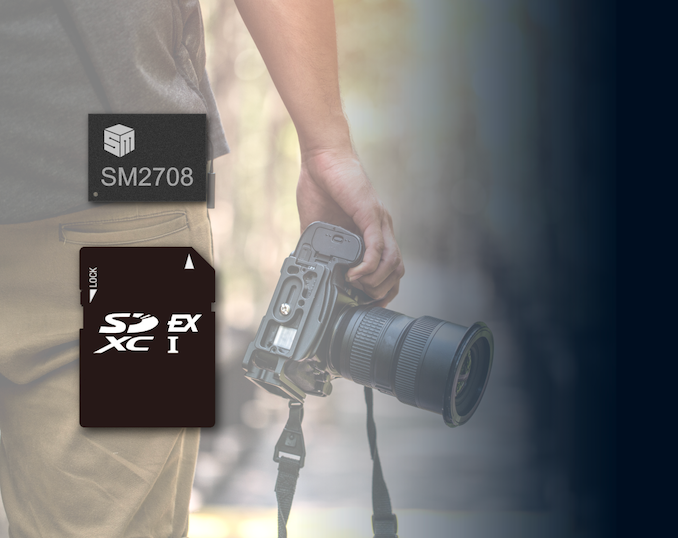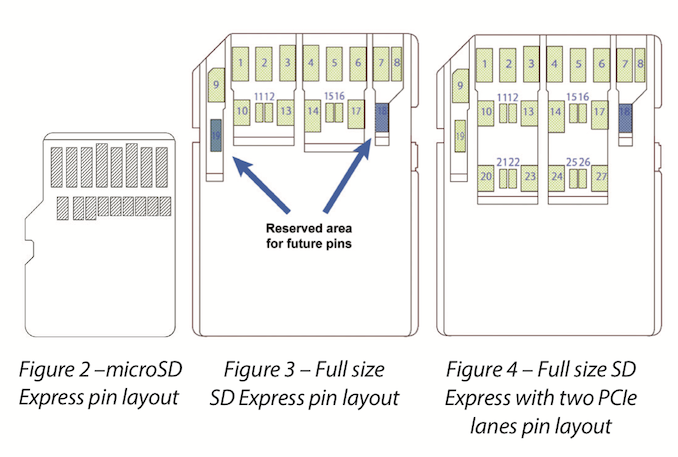Silicon Motion Announces SM2708 SD Express Controller
by Billy Tallis on April 7, 2021 4:30 PM EST- Posted in
- SD Express
- Storage
- SD cards
- NVMe
- Silicon Motion

Silicon Motion has announced their first SD Card controller to support the NVMe-based SD Express interface. The new SM2708 controller is capable of sequential transfer speeds of 1700 MB/s, vastly higher than the 104 MB/s most SD devices and cards are limited to using the older but widely-supported UHS-I interface.
In 2018, version 7.0 of the SD specification introduced the PCIe and NVMe-based SD Express interface as the new way forward for SD cards. The older UHS-II and UHS-III interfaces developed in versions 4 through 6 of the SD standard and capable of speeds from 156 MB/s to 624 MB/s were abandoned in favor of a single lane of PCIe gen3 (~985 MB/s). Last year, version 8.0 of the SD specification added support for PCIe gen4 speeds and a second PCIe lane, bringing the theoretical maximum transfer speed up to almost 4 GB/s.
Silicon Motion's SM2708 is a two-lane controller, but still using PCIe gen3 speed, hence the top speed can't quite reach 2 GB/s. This has the potential to bring SD card performance up to near the levels of entry-level consumer NVMe SSDs for laptops and desktops—competitive with SSDs based on slightly-outdated controllers like the Phison E8T or Silicon Motion SM2263XT. The SM2708 controller uses two NAND channels instead of the four typically used by entry-level SSD controllers, but the SM2708 is capable of a 1200 MT/s IO speed that allows it to get good performance out of recent NAND flash generations without the power and size penalties of a four-channel solution.
In 2019, Silicon Motion's primary competitor Phison announced their PS5017 SD Express controller. This is based on the earlier SD 7.0 specification and thus is a PCIe 3 x1 design and limited to about 870 MB/s. In February 2021 Phison announced they were about to start shipping cards based on this solution. Silicon Motion's SM2708 controller might not take that long to turn into actual products, but they clearly have missed out on the first round of SD Express competition—though they may be able to leapfrog Phison's solution.
Underlying all the developments related to recent flash memory card standards has been the challenge of poor adoption. For years, storage tech has been advancing much faster than camera tech. Storage technology companies stand ready to supply more advanced memory cards, but they cannot succeed in the market unless there are host devices ready to use the higher performance. We've seen a decade of failed successors to the old SD and CF standards that now seem pitifully slow. SD's UHS-II and UHS-III, CF's CFast and XQD, and UFS cards have all been demonstrated as working technologies and all eventually made it to market to some extent, but with very limited success. The SD and CF worlds have converged on PCIe and NVMe as the way forward, adopting interfaces that already have a thriving ecosystem and long-term viability in other form factors. That makes it more likely that standards like SD Express will actually catch on, but it may still be several years before PCIe-based interfaces are supported on any phones or more than a handful of high-end cameras.
Source: Silicon Motion











17 Comments
View All Comments
dotjaz - Thursday, April 15, 2021 - link
That's not true. A standard should be good enough for its intended market. For lossless wave-based sound recordings, it has to cover not just pop music but also classic concerts and rock music which can quite easily exceed 96dB. Also you can't assume 20dB noise floor for the RECORDING environment. You listen to 96dB of dynamic range in a 20dB environment, you don't reproduce the recorded dynamic range, that's not to say the dynamic range is lost.I agree 120dB is probably overkill when it comes to consumer products but you have to remember, the most common format is AAC/Vorbis/Opus etc, they practically don't have a limit on dynamic range, a more "accurate" master file will actually give you better end encodings, therefore high bit depth is more important that ever because "bit depth" itself has largely become irrelevant to consumers.
Tomatotech - Thursday, April 8, 2021 - link
Finally. Buying a SD or CF card has been a minefield of different standards and speeds, as well as a swirling morass of fake cards and fake capacities.Looking forward to a MicroSD card around the size of my fingernail, 1mm thick, with 1TB of nvme storage at 2GB/sec for around £/$100.
Strange to think user-level storage is increasingly becoming a solved problem. Many non-technical people literally have no idea how much storage is available / remaining on their laptops / phones / smartwatches / ipads / cloud accounts. They just know it's 'enough'. Thanks to the wonders of cloud storage and tiered storage and download-on-demand storage.
Linustechtips12#6900xt - Thursday, April 8, 2021 - link
so an SD CARD is better than a sata or a decent pcie 3.0 ssd, WOWDanNeely - Thursday, April 8, 2021 - link
A non-terrible PCIe3 SSD will crush this all around. It's only got the equivalent of 2 PCIe3 lanes worth of bandwidth.In addition, nvme sd card's are dramless without being able to use system memory as cache, and will have a very low number (almost certainly just 1) of flash stacks; which will hurt them badly for random IO. For general use I wouldn't be surprised if that makes a decent SATA SSD faster.
OTOH the NVME SD Card should be faster for sequential read/write than a SATA SSD. Which is all that really matters, the intended use case for these cards are super high end cameras recording 4k or higher video, or bursts of super high resolution images. (eg sport photography where you need both crazy megapixels so your target looks good after you massively crop because you need to take a wide view to make sure you've got the athlete in the shot and need to take a ton of pictures really fast because you can't time the catch/etc perfectly by hand.)
KarlKastor - Monday, April 12, 2021 - link
HMB is part of the SD Spec. It will depend on the Host device.But else I agree with you totally. Another thing is TDP. 1.8W is maximum for a SD card. This will limit maximum peformance as well.
But it really does not matter. It delivers a high enough transfer rate and much better latency than the previous SD-Interface.
eastcoast_pete - Saturday, April 10, 2021 - link
If those will work in micro SD format cards and with very limited power draw, I'm in. Of course, just as those come on line, more and more smartphone brands are eliminating micro SD card slots.nandnandnand - Sunday, April 11, 2021 - link
They live on in some laptops, tablets, single-board computers, and cameras.